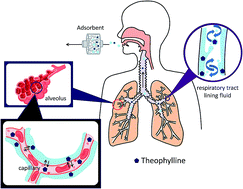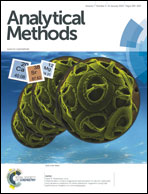Design and development of a suitable adsorbent to capture theophylline for non-invasive therapeutic drug monitoring with exhaled breath
Abstract
The possibility of using exhaled breath as a substitute for blood/plasma in areas of therapeutic drug monitoring was investigated. Theophylline was used as a model chemical of non-volatile drugs and the adsorbents suitable for drug capture from exhaled breath were studied. Two macro-porous adsorbents with different monomer compositions were prepared by suspension copolymerization. The capture properties of the synthesized adsorbents and two conventional gas adsorbents packed in a cartridge were evaluated by both aerosol generation and rat expiration. The efficiency of drug capture did not improve by decreasing the pore size and by increasing the specific surface area. A hydrophilic region was found to be necessary for holding the aerosol particles on the adsorbent surface, but a hydrophobic region is also necessary for the adsorption of theophylline. The materials were applied to the intravenous bolus experiment of rats. The amount of theophylline collected from exhaled breath was in the range of 0–0.02 ng min−1, and it varied similarly to the concentration in blood, which was in the range of 0–37 μg mL−1.


 Please wait while we load your content...
Please wait while we load your content...